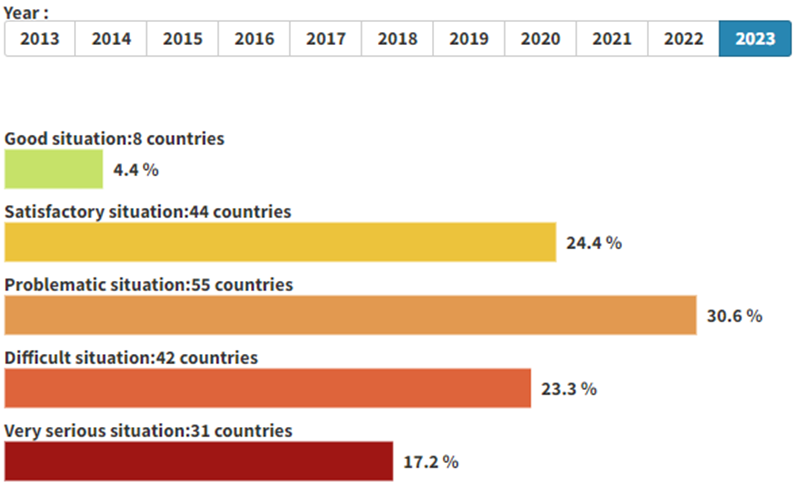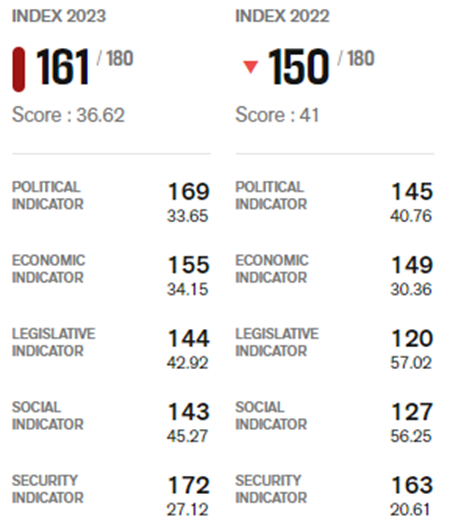World Press Freedom Index 2023
26-08-2023
12:28 PM
1 min read

What’s in today’s article?
- Why in News?
- What is the World Press Freedom Index?
- The World Press Freedom Index 2023
- Situation in India
- Indian Government’s take on the Previous World Press Freedom Index
- Steps Taken by Indian Government to Promote Press Freedom
Why in News?
- Media associations in the country have voiced concern over India slipping 11 places to 161st rank in the World Press Freedom Index 2023.

What is the World Press Freedom Index?
- It is an annual ranking of countries compiled and published by France-based global media watchdog Reporters Without Borders (RSF) since 2002.
- It intends to reflect the degree of freedom that journalists, news organisations, and netizens have in each country, and the efforts made by authorities to respect this freedom.
- It only deals with press freedom and does not measure the quality of journalism in the countries it assesses, nor does it look at human rights violations in general.
- A new methodology devised in 2021 is based on a definition of press freedom as
- the ability of journalists as individuals and collectives
- to select, produce, and disseminate news in the public interest
- independent of political, economic, legal, and social interference and
- in the absence of threats to their physical and mental safety.
- It uses five new indicators: political context, legal framework, economic context, sociocultural context and safety.
The World Press Freedom Index 2023:
- It evaluates the environment for journalism in 180 countries and territories and Norway is ranked first for the seventh year running.
- The last three places are occupied by: Vietnam, China, and North Korea (180th).
- This Index spotlights the rapid effects that the digital ecosystem’s fake content industry has had on press freedom.
- The difference is being blurred between true and false, real and artificial, facts and artifices, jeopardising the right to information.
- Last in the regional ranking, the Middle East and North Africa (MENA) continues to be the world’s most dangerous region for journalists.

Situation in India:

- The situation has gone from “problematic” to “very bad” in India, along with Tajikistan and Turkey.
- In India, media takeovers by oligarchs close to the government have jeopardised pluralism and restricted free flow of information.
Indian Government’s take on the Previous World Press Freedom Index:
- Freedom of speech and expression (press freedom is a part of it) is a constitutionally guaranteed fundamental right to citizens under Article 19(1) with restrictions as stated in Article 19(2).
- Under the Article 19(2), the state is empowered to impose reasonable restrictions on the operation of the right in the interest of
- Sovereignty and integrity of India,
- Security of the state,
- Friendly relations with foreign states,
- Public order, decency or morality or
- In relation to contempt of court, defamation or incitement to an offence
- The government does not subscribe to the country’s ranking and to the conclusions drawn by the Index.
- This was due to various reasons, including very low sample size, little or no weightage to fundamentals of democracy, adoption of a methodology which is questionable and non-transparent.
Steps Taken by Indian Government to Promote Press Freedom:
- G7 countries and partner countries (including India) adopted a ‘Resilient Democracies Statement’ at the 2022 G7 Summit affirming their commitment to strengthening the resilience of democracies.
- An advisory on the safety of journalists was issued to states and UTs in 2017, requesting them to strictly enforce the law to ensure the safety and security of media persons.
- The Press Council of India (PCI), a statutory autonomous body, has been set up under the Press Council Act, 1978.
- It considers complaints filed ‘by the press’ concerning curtailment of press freedom, physical assault/attack on journalists, etc.
- For television, all channels are required to adhere to the Programme Code under the Cable Television Networks (Regulation) Act, 1995.
- For digital news publishers, the IT (Intermediary Guidelines and Digital Media Ethics Code) Rules, 2021 under the IT Act, 2000, has been notified.
Q1) Why is the media considered as the fourth pillar of democracy?
Media is considered as the fourth pillar of democracy because it provides information about the conditions and requirements of the people in the country, thus playing an important role in keeping the democracy alive and thriving.
Q2) What is the mandate of the Press Council of India (PCI)?
The PCI was established under the PCI Act of 1978 for the purpose of preserving the freedom of the press and of maintaining and improving the standards of newspapers and news agencies in India.
Source: India slips to 161 on World Press Freedom Index; media associations voice concern | RSF | IE
